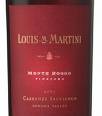 I always take away a few useful observations from the Combat des Vins, an annual event at San Diego’s Le Fontainebleau in which I compare and contrast wines paired with a seven-course dinner prepared by Chef Fabrice Hardell.
I always take away a few useful observations from the Combat des Vins, an annual event at San Diego’s Le Fontainebleau in which I compare and contrast wines paired with a seven-course dinner prepared by Chef Fabrice Hardell.
There were 17 wines in total this year (the dinner was Thursday night). Though guests are invited to indicate a preference with each course by a show of hands, keeping score is not the focal point of the evening. That would be discovery and discussion.
As I look back at my tasting notes, three red wines — the 2002 Louis Martini Monte Rosso Cabernet Sauvignon, the 2001 Spring Mountain Elivette and the 2004 Parallel Cabernet Sauvignon — give me a lesson in vinous geography.
 The Martini Monte Rosso is a Cabernet from the Sonoma side of the Mayacamas Mountains, and thus closest to the ocean. The Spring Mountain is a red Bordeaux blend from the Napa side of the Mayacamas, further from the ocean and thus a bit warmer. Being on the west side of the Napa Valley, it also gets the morning sun. Finally, the Parallel is a Cabernet (barely, as Cabernet Sauvignon is a mere 75 percent of the blend) from the east side of the Napa Valley around Howell Mountain, making it the furthest from the ocean and warmer still. Its vineyards catch the afternoon sun.
The Martini Monte Rosso is a Cabernet from the Sonoma side of the Mayacamas Mountains, and thus closest to the ocean. The Spring Mountain is a red Bordeaux blend from the Napa side of the Mayacamas, further from the ocean and thus a bit warmer. Being on the west side of the Napa Valley, it also gets the morning sun. Finally, the Parallel is a Cabernet (barely, as Cabernet Sauvignon is a mere 75 percent of the blend) from the east side of the Napa Valley around Howell Mountain, making it the furthest from the ocean and warmer still. Its vineyards catch the afternoon sun.
These three mountain reds, from roughly the same part of the world, have many similarities. But upon close inspection, there are many differences as well.
Not surprisingly, my notes indicate the Monte Rosso most exhibits the characteristics of a genuine Bordeaux red, with a subtle herbal, peppery note on the nose, hints of cedar and blackcurrant, a medium, elegant weight and firm tannins. Stands to reason because of its cooler vineyard.
The Elivette nose was chocolately, and the structure of the wine more dense and layered, with darker fruits and slightly sweeter tannins than the Monte Rosso.
 The Parallel was the richest and most textured of the three, showing intense cassis and black cherry fruit, loads of spice and an impressive elegance despite its palate weight.
The Parallel was the richest and most textured of the three, showing intense cassis and black cherry fruit, loads of spice and an impressive elegance despite its palate weight.
Winemaking techniques and viticultural variations aside, I’m of the opinion that the biggest factor contributing to the differences in the three wines is temperature, or how far the vineyards are from the ocean.
They do have one thing in common, however. Each one is an exceptional bottle of wine.
8
